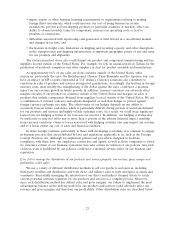HP 2009 Annual Report Download - page 34
Download and view the complete annual report
Please find page 34 of the 2009 HP annual report below. You can navigate through the pages in the report by either clicking on the pages listed below, or by using the keyword search tool below to find specific information within the annual report.impact inventory levels and results of operations in a manner that is disproportionate to the number of
days in the quarter affected.
We experience some seasonal trends in the sale of our products that also may produce variations
in quarterly results and financial condition. For example, sales to governments (particularly sales to the
United States government) are often stronger in the third calendar quarter, consumer sales are often
stronger in the fourth calendar quarter, and many customers whose fiscal and calendar years are the
same spend their remaining capital budget authorizations in the fourth calendar quarter prior to new
budget constraints in the first calendar quarter of the following year. European sales are often weaker
during the summer months. Demand during the spring and early summer also may be adversely
impacted by market anticipation of seasonal trends. Moreover, to the extent that we introduce new
products in anticipation of seasonal demand trends, our discounting of existing products may adversely
affect our gross margin prior to or shortly after such product launches. Typically, our third fiscal
quarter is our weakest and our fourth fiscal quarter is our strongest. Many of the factors that create
and affect seasonal trends are beyond our control.
Any failure by us to execute on our strategy for operational efficiency successfully could result in total costs
and expenses that are greater than expected.
We have adopted an operating framework that includes a disciplined focus on operational
efficiency. As part of this framework, we have adopted several initiatives, including a multi-year
program announced in 2006 to reduce real estate costs by consolidating several hundred HP real estate
locations worldwide to fewer core sites, and a multi-year process of examining every function and every
one of our businesses and functions in order to optimize efficiency and reduce cost. We have also
implemented a workforce restructuring program in fiscal 2008 relating to our services business and a
workforce restructuring program in fiscal 2009 relating to our product businesses.
Our ability to achieve the anticipated cost savings and other benefits from these initiatives within
the expected time frame is subject to many estimates and assumptions, including estimates and
assumptions regarding the cost of consolidating real estate locations, the amount of accelerated
depreciation or asset impairment to be incurred when we vacate facilities or cease using equipment
before the end of their respective lease term or asset life, and the costs and timing of other activities in
connection with these initiatives. These estimates and assumptions are subject to significant economic,
competitive and other uncertainties, some of which are beyond our control. In addition, there are
significant risks associated with our workforce restructuring programs, including potential delays in the
implementation of those programs in highly regulated locations outside of the United States,
particularly in Europe and Asia, decreases in employee morale, and the failure to meet operational
targets due to the loss of employees. If these estimates and assumptions are incorrect, if we experience
delays, or if other unforeseen events occur, our business and results of operations could be adversely
affected.
In order to be successful, we must attract, retain and motivate key employees, and failure to do so could
seriously harm us.
In order to be successful, we must attract, retain and motivate executives and other key employees,
including those in managerial, technical, sales, marketing and IT support positions. Hiring and retaining
qualified executives, engineers, skilled solutions providers in the IT support business and qualified sales
representatives are critical to our future, and competition for experienced employees in the IT industry
can be intense. The failure to hire executives and key employees or the loss of executives and key
employees could have a significant impact on our operations.
27
























